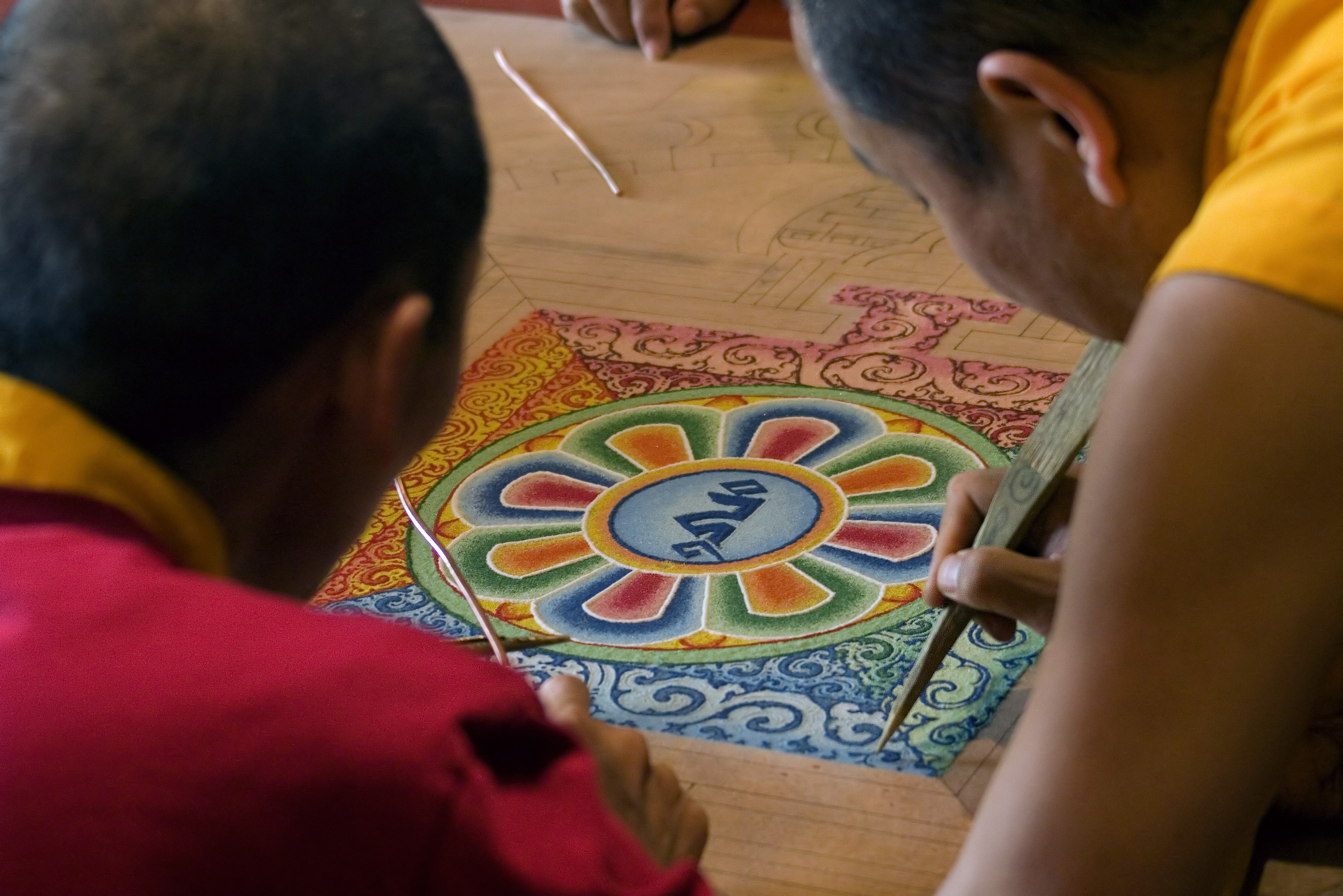Painting with sand

The Hammer Museum, along with Ari Bhöd, will be showcasing The Mandala Project. The two-week program will feature the construction of a Tibetan sand mandala by a team of traditionally trained Lamas from the Thubten Choeling Monastery in Pharping, Nepal.
Credit: AMERICAN FOUNDATION FOR TIBETAN CULTURAL PRESERVATION
By Madeleine Flynn
Oct. 25, 2010 1:27 a.m.


Tibetan Lamas use metal funnels to create mandala designs with grains of colored sand and ground stone.
Credit: AMERICAN FOUNDATION FOR TIBETAN CULTURAL PRESERVATION
Living so close to many of California’s most famous beaches, residents of Los Angeles get a lot of one-on-one face time with sand. However, when it comes to the white, grainy stuff, the true experts might be Tibetan monks.
For thousands of years, Tibetan Lamas have perfected the art of painting with sand. Using small, metal funnels, they delicately pour millions of grains of colored sand or ground stone onto a wooden platform in intricate patterns to form a single, massive mandala, a sacred symbol in Tibetan Buddhism. The colors of the sand and each design in the Tibetan mandala incorporate a carefully chosen spiritual significance.
Beginning Tuesday Oct. 26, the Hammer Museum will welcome a team of Lamas from the Thubten Choeling Monastery in Nepal as part of The Mandala Project, during which the public will be able to watch the Lamas create their own sand mandala.
“Only a handful of artists possess the vast knowledge of Buddhist ritual, symbolism and philosophy that is needed to actually create these mandalas,” said Allison Agsten, curator of public engagement and director of visitor services at the Hammer Museum. “They’re definitely very holy men.”
The project will culminate on Nov. 7 when the finished mandala is ceremoniously swept up and the sand is poured into the Pacific Ocean.
According to Agsten, it’s a symbolic action, representing the impermanence of the world.
Emilia Rizzo, a UCLA Extension marketing and media management student visiting the museum, was interested in the concept of sand painting and surprised by how detailed a sand mandala could be.
“It looks like a carpet,” she said, while looking at a poster promoting the project. “(There are) all kinds of colors ““ green, red, blue ““ but you can’t tell if it’s a real carpet or not.”
A sculpture by mandala expert and artist Pema Namdol Thaye will accompany the sand painting, along with drawings by architect Michael Rotondi. Thaye’s and Rotondi’s works are models and blueprints, respectively, of a one-of-a-kind building to be constructed in the Tehachapi Mountains for Ari Bhöd, the Tibetan cultural foundation that partnered with the Hammer Museum for this project. The building’s design is inspired by the design of a traditional mandala.
“This will be, in laymen’s terms, the “˜coolest’ building of this era, I would say,” Thaye said. “It’s something, like not only in the West, but we don’t even have this in the East. So it’ll be a monument, once we’re able to build it.”
Thaye’s sculpture is based on blueprints from the seventh century that were passed down from previous enlightened figures.
It took about two years to plan and construct, and will complement the Lamas’ sand mandala.
According to Thaye, while artists use the deep concentration necessary to create a mandala as a tool for meditation, the average viewer can also gain something by simply seeing a Tibetan mandala.
“The main purpose of the mandala is to help liberate every being,” he said. “It’s probably the most powerful tool in Buddhism.”
The Mandala Project will offer visitors the chance to witness a sacred form of cultural and artistic expression.
“As museums we often do a really great job of showing finished pieces, but I think it will be particularly interesting for our audience to be able to see a significant work of art being created,” Agsten said. “The art making process is really special, and in this case, sacred.”
Ultimately, Thaye and Agsten said that they hope visitors can experience some of the spiritual power of the Tibetan mandala by visiting the exhibit.
“We are the mandala,” Thaye said. “We have that nature right inside us. … Then, if we are able to look inwards, we are able to focus our heart, to get it liberated and (become) enlightened.”


